Like most of you, I enjoy attending major ophthalmic meetings for a variety of reasons, among them the voluminous information you can learn and the countless interactions you can have with colleagues. At the AECOS (American-European Congress of Ophthalmic Surgery) European Symposium in Prague this summer, I was able to do both. To recap the entire meeting would be nearly impossible, as so many relevant and timely topics were discussed; however, four talks in which data were presented for the first time worldwide are highlighted herein.
Ina Conrad-Hengerer, MD, presented for the first time in public the FDA data on the RxLAL (RxSight; formerly Calhoun Vision). The light-adjustable lens, which during the study was implanted after standard cataract surgery performed at one of 17 US clinical sites, can undergo postoperative adjustments of up to 2.00 D sphere and 2.00 D cylinder.
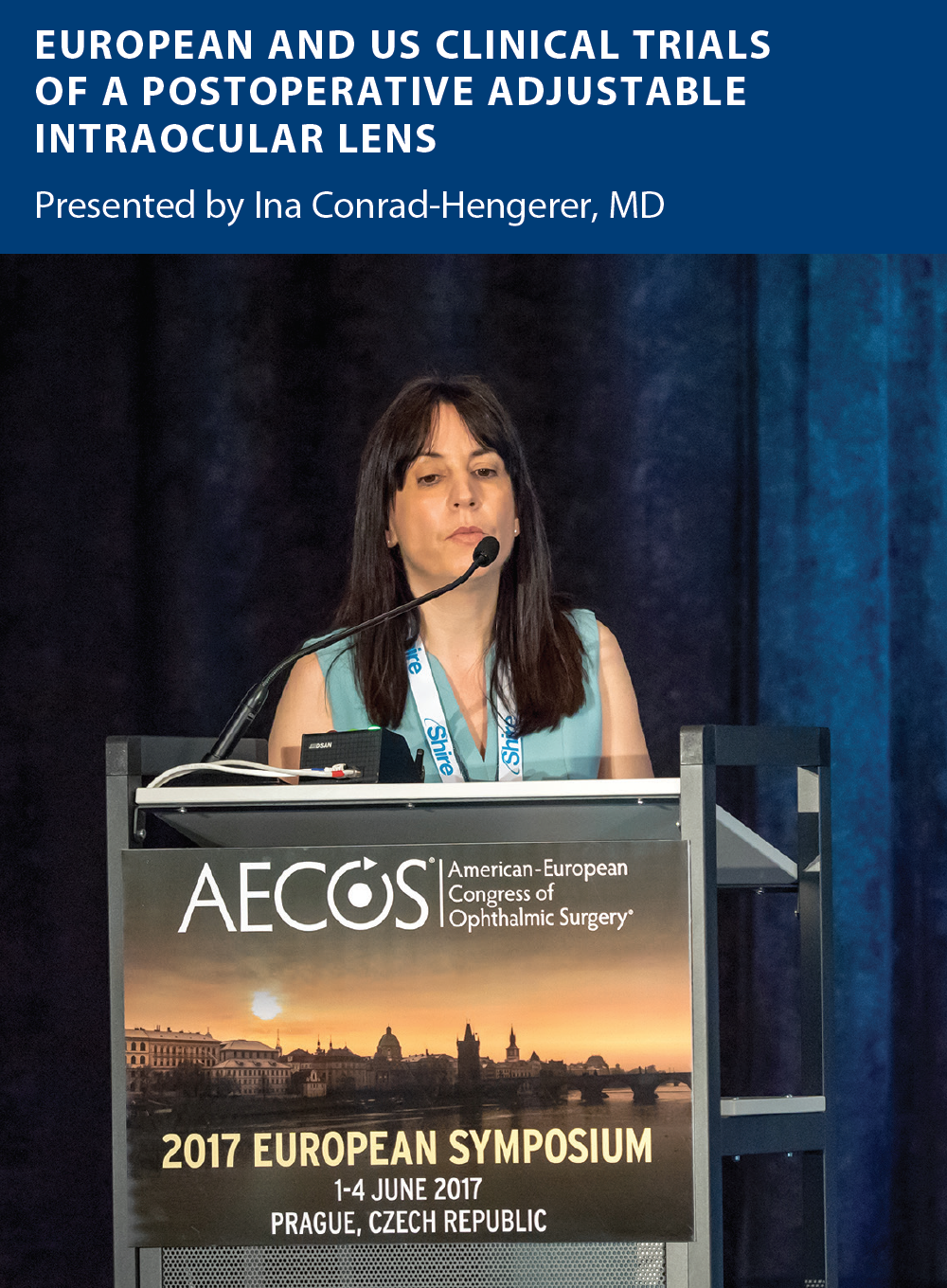
FDA premarket submission is now complete, Dr. Conrad-Hengerer said. In that submission, she said, the results from 391 RxLAL surgeries were compared with results from 193 control surgeries with a standard monofocal IOL matched by the amount of preoperative cylinder (maximum cylinder, 2.75 D). Six months postoperatively, corrected distance visual acuity in the RxLAL eyes was 20/40 or better in 100% of eyes, compared with 74.4% preoperatively and 99.8% prior to adjustment. When cylinder reduction was measured, the researchers found that all eyes were within ±0.75 D of target refraction.
Dr. Conrad-Hengerer reported that, when the FDA data for the RxLAL were compared with FDA data for the AcrySof Toric IOL (Alcon), a higher percentage of patients achieved a UCVA of 20/25 (92% vs 66%) and 20/20 (70% vs 38%) with the RxLAL. In particular, the latter result indicated an almost twofold improvement in 20/20 UCVA over the nonadjustable IOL. Further, more than 90% of RxLAL patients had a manifest refraction spherical equivalent (MRSE) of ±0.50 D, which is similar to LASIK results (90.3 vs 90.9%), she said.
Only a few trials to date have been conducted with extended-depth-of-focus (EDOF) IOLs, and only one of these, presented at the 2017 AECOS European Symposium in Prague, has compared two EDOF models. Presenting early results of a prospective, randomized, comparative trial of the IC-8 (AcuFocus) and the Tecnis Symfony (Johnson & Johnson Vision), Merita Schojai, MD, said that both IOLs provided very good refractive outcomes.
The IC-8 is a one-piece, hydrophobic acrylic, small-aperture IOL that uses an embedded black circular mask to block unfocused rays of light and provide extended depth of focus. It received the CE Mark in September 2014 but is not available in the United States. The Tecnis Symfony, which is marketed as an extended-range-of-vision IOL, received the CE Mark in June 2014 and FDA approval in July 2016.
The study included 37 patients randomly assigned to receive a monofocal IOL in the dominant eye and the IC-8 in the nondominant eye or the Tecnis Symfony in both eyes. All surgeries were performed by H. Burkhard Dick, MD, PhD, and the target refraction in all cases was plano in the dominant eye and -0.50 to -0.75 D in the nondominant eye. There were no intra- or postoperative complications.
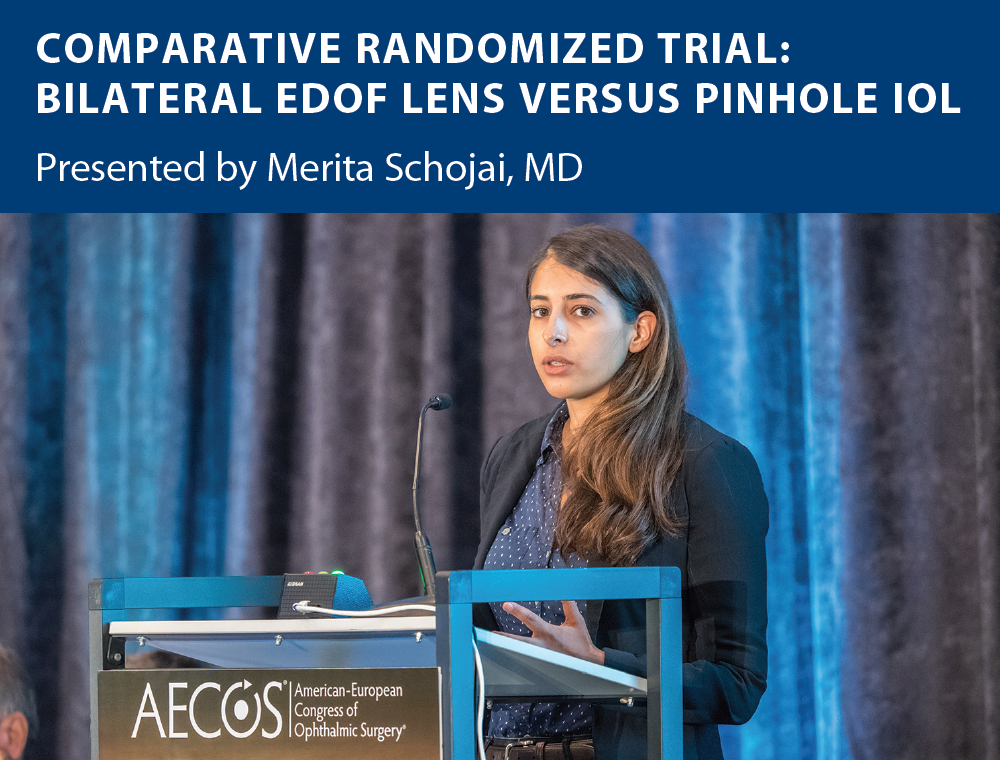
At the time of Dr. Schojai’s presentation, 4-week follow-up data were available. In the dominant eyes in the IC-8 group, the mean MRSE was 0.06 D, compared with -0.14 D in the Symfony group. The mean MRSE in the nondominant eyes of patients in the IC-8 and Symfony groups was -0.54 and -0.65 D, respectively. This showed that both the IC-8 and Symfony IOLs provided results close to the target refraction of -0.50 to -0.75 D, Dr. Schojai said. Mean cylinder 4 weeks postoperatively was -0.50 D in the IC-8 group and -0.61 D in the Symfony group; however, there were a few cases of patients near the -1.00 D range after 4 weeks, she said.
Further, an uncorrected distance visual acuity (UDVA) of 20/20 or better was achieved by almost 80% of IC-8 patients and 60% of Symfony patients, with more than 60% and 40% of patients, respectively, gaining 1 line of UDVA. The defocus curve also showed very good intermediate vision (20/30) and good near vision (20/40) with both IOLs.
These early results, Dr. Schojai said, suggest that both IOLs provide very good refractive outcomes, with a low deviation from target refraction. She also noted that the IC-8 provided slightly better UDVA 4 weeks postoperatively but that longer-term results are needed to confirm this result.
Matthias Elling, MD, presented early results with epithelium-on (epi-on) photorefractive intrastromal corneal cross-linking (PiXL) for the treatment of myopia with the Mosaic System (Avedro) in 40 healthy eyes with no more than -0.75 D cylinder. Patients were divided into two groups based on myopic error (-1.00 to -1.75 D, group 1, and -2.00 to -3.00 D, group 2), and all procedures were supplemented with oxygen in order to boost the treatment effect. Patients in group 1 received an ultraviolet A dose of 10 J/cm2 and group 2 a dose of 15 J/cm2. All procedures used a 4-mm treatment zone and pulsed radiation at 1 second on/1 second off duration. The first treatment was performed in August 2016.
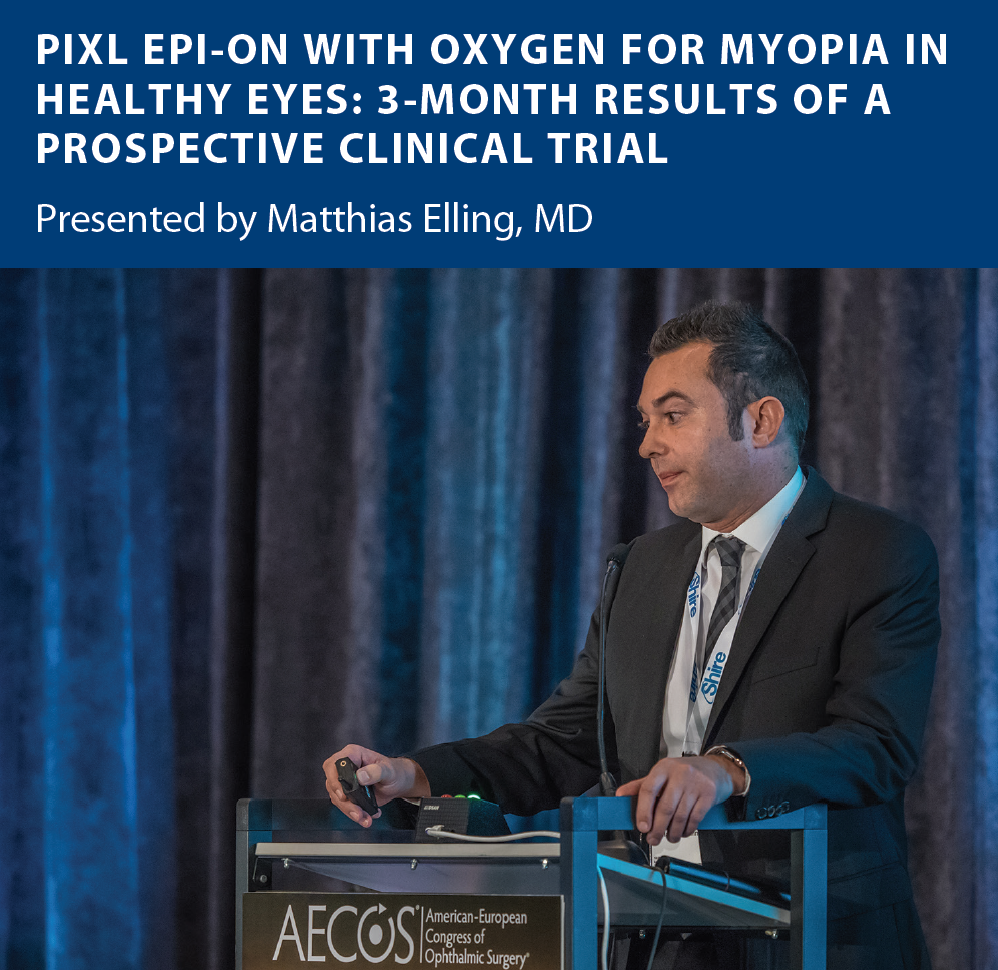
In this ongoing 12-month prospective evaluation, follow-up is scheduled for 1 day, 1 week, and 1, 3, and 6 months postoperatively. At the 2017 AECOS European Symposium, 3-month results were available. Of particular note, Dr. Elling said, BCVA was stable, and there was a significant improvement in UCVA, from 0.6 logMAR preoperatively to 0.2 and 0.0 logMAR at 1 and 3 months, respectively. Pachymetry was what one would expect after a corneal cross-linking treatment, he said: there was a slight decrease of corneal thickness within 1 month postoperatively, from 552 to 542 µm, but it rebounded to 553 µm at 3 months postoperatively. Endothelial cell count was also stable by 1 month (preoperative mean, 2,896 cells/mm2; postoperative mean, 2,796 cells/mm2).
Dr. Elling said in conclusion that the first results with epi-on PiXL showed stability by 1 month and a mean myopic reduction of up to 1.59 D by 3 months. The procedure is intended for the treatment of moderate myopia of up to -2.00 D in healthy eyes. Long-term stability is unknown, but early results are promising, he said, adding that increased treatment predictability and a nomogram are still needed.
Why You Should Mark Your Calendar for AECOS Europe 2018
With the wide selection of ophthalmic meetings held throughout the year, our calendars can fill up rather quickly. Over the years, many of us have learned to be selective about which ones we attend. Despite a wide range of alternatives, the two of us rarely miss the meetings put on by the American-European Congress of Ophthalmic Surgery (AECOS)—one in the winter, in Aspen, Colorado, and two in the summer, in a varying European location and in Deer Valley, Utah. What is so special about these meetings is the opportunities they present for true discussion and dialogue among colleagues, both fellow ophthalmologists and industry members.
The 2017 AECOS European Symposium took place in Prague, with a full house of attendees. As the outgoing (Arthur) and incoming (Burkhard) AECOS presidents, we were happy to welcome everyone to AECOS Prague, where former Czech Republic President Václav Klaus officially opened the symposium. This introduction to the meeting and to the location set the mood for a productive and enjoyable exchange of ideas and information over the next 3 days.
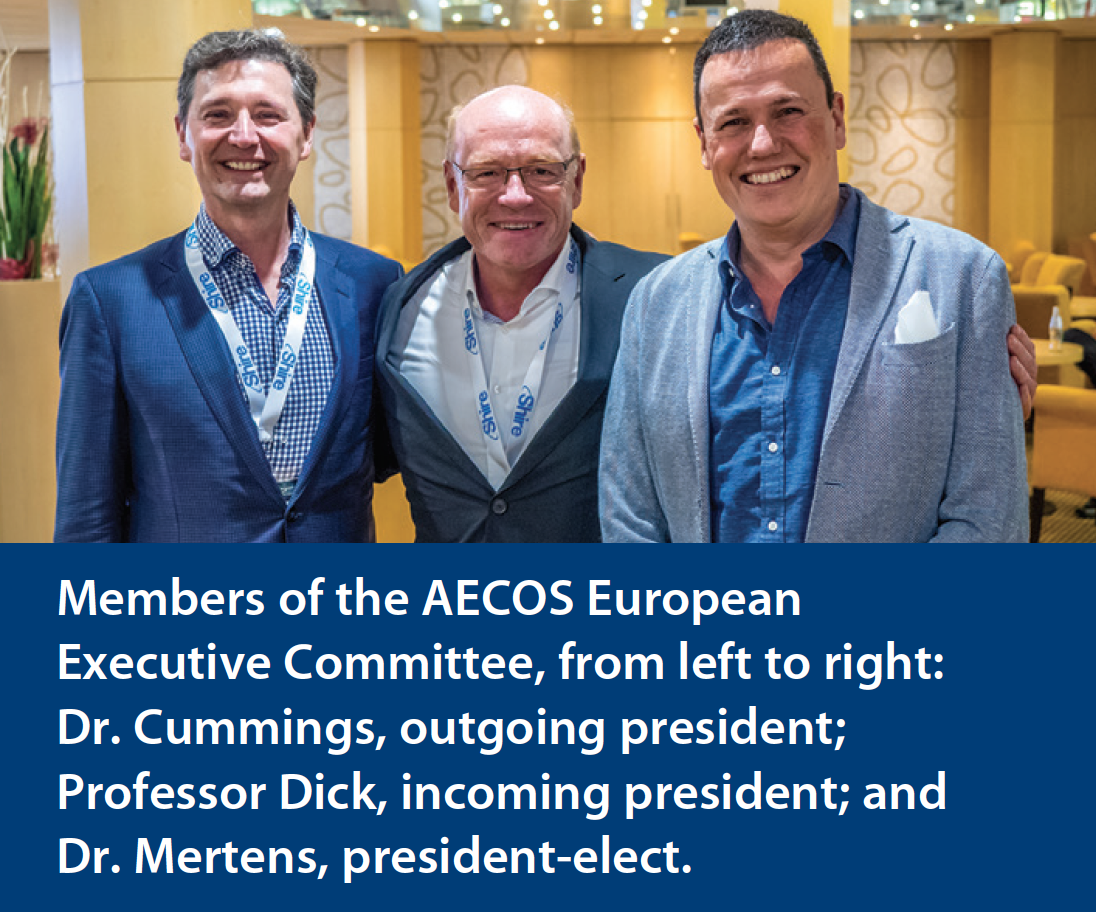
It is not easy to recap a meeting such as AECOS, because in addition to the unparalleled program, an equal element of its success is the discussions that take place after and even during the presentations. Under the chairmanship of Erik L. Mertens, MD, FEBO, the program included a Shark Tank session rating new and recent technologies, a European regulatory update, a session on how microinvasive glaucoma surgery may be funded in Europe, an overview of available capsulotomy devices, and a session on barriers to the adoption of certain devices or technologies. In this session, passionate arguments were made on behalf of manufacturers and distributors to educate nonbelievers on the power of some of those devices and technologies.
Other discussions revolved around keratoconus and corneal cross-linking, dry eye diagnosis and management, modern practice management, the patient’s experience, modern LASIK, presbyopia, and video grand rounds. Industry executives also got time on the podium, when they had the opportunity to ask the audience questions about the direction of their technologies in attempts to help them make corporate decisions to further improve their products.
There is also plenty of time to socialize during AECOS meetings. This time, we had the opportunity to do so during a beautiful gala dinner at the Lobkowicz Palace in Prague Castle.
Feedback from the multinational, highly engaged audience to AECOS committee members was positive. Many stated that this was one of their favorite ophthalmology conferences. Overall, the meeting could only be described as an overwhelming success. AECOS is in great hands with Professor Dick and president-elect Dr. Mertens at the helm, and the congress is poised to go from strength to strength. If we were you, we would make sure that AECOS Berlin 2018 is on your conference calendar.
Arthur B. Cummings, MBChB, FCS(SA), MMed (Ophth), FRCS(Edin), outgoing AECOS president
H. Burhkard Dick, MD, PhD, incoming AECOS president
Speaking on the last day of the 2017 AECOS European Symposium, incoming president Professor Dick shared postmarket multicenter trial results with the IC-8 IOL. The study, which was conducted across 12 sites in Germany, Austria, Spain, Italy, Belgium, and Norway, included 6-month follow-up data from 108 patients.
All patients enrolled in the study received the IC-8 implant in their nondominant eye and an aspheric monofocal IOL in their dominant eye. Six months postoperatively, the monocular distance, intermediate, and near UCVA was 0.87, 0.83, and 0.66, respectively. The mean MRSE in the eye that received the IC-8 was -0.42 D, compared with 0.01 D in the eye with the aspheric monofocal IOL. Even more impressive was the binocular UCVA, Professor Dick said, which for distance, intermediate, and near was 1.15, 0.91, and 0.69, respectively. When the A-constant was optimized to target -0.75 D in the IC-8 eye and plano in the monofocal eye, binocular UCVA at 6 months improved to 1.20, 0.95, and 0.71 for distance, intermediate, and near, respectively.
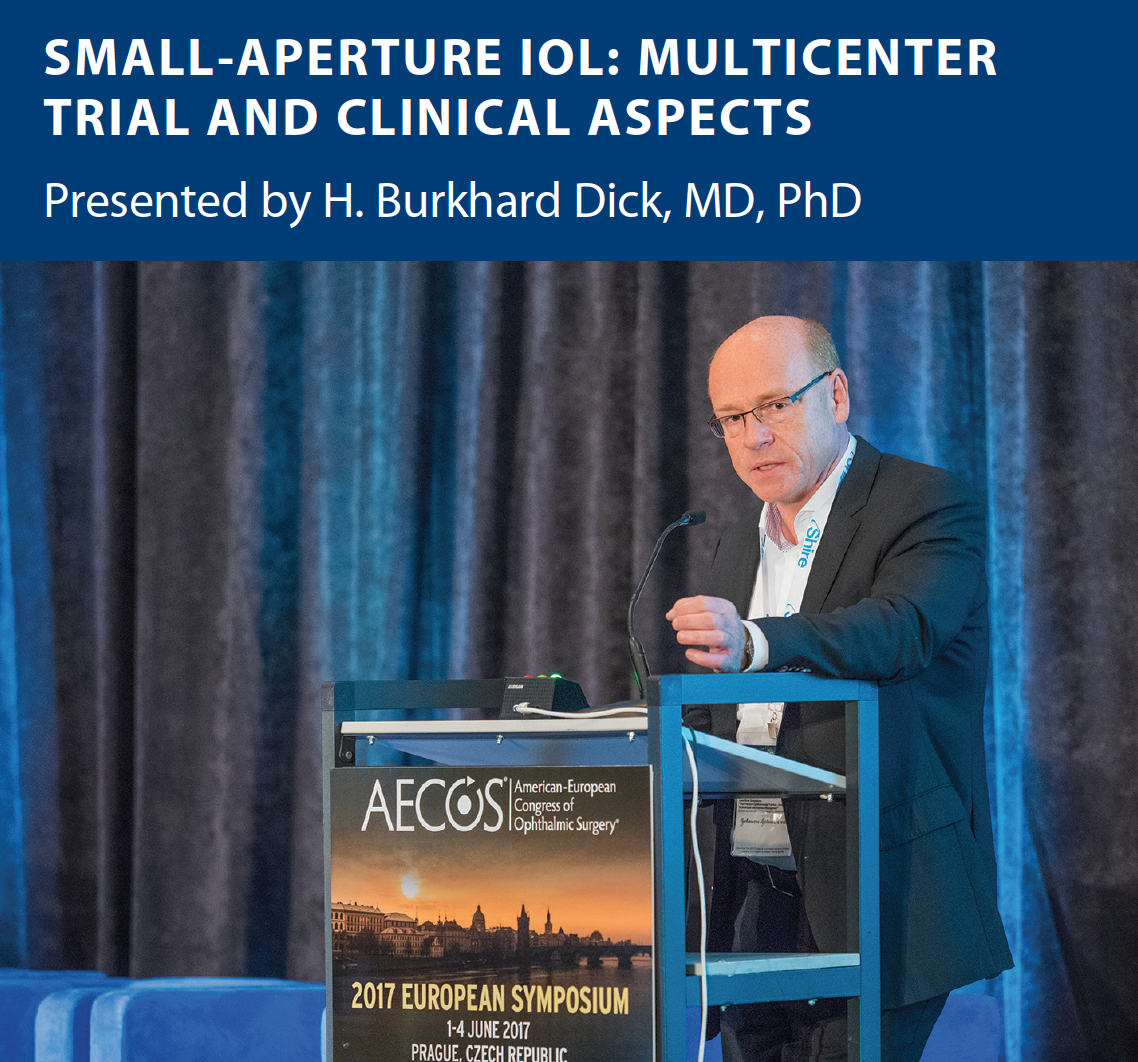
Professor Dick and colleagues also found that the IC-8 provided binocular contrast sensitivity equivalent to that of the monofocal IOL but that a slight decrease in mesopic contrast sensitivity occurred. The IC-8 tolerated up to ±1.00 D deviation from target refraction and up to 1.50 D corneal cylinder, a degree of error that is not well tolerated with a monofocal IOL.
Bilateral implantation can increase depth of focus even further, Professor Dick said, but this was not part of the multicenter trial.




